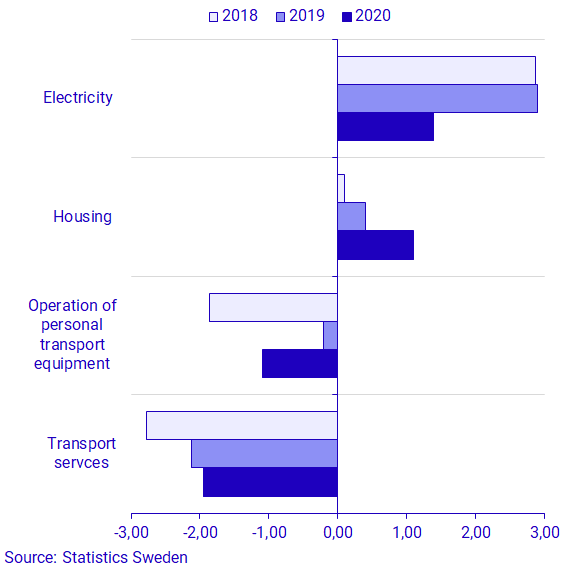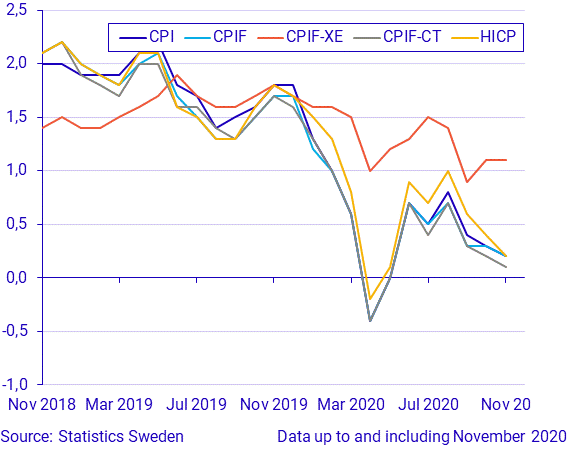Consumer Price Index (CPI), November 2020
Inflation rate was 0.2 percent in November 2020
Statistical news from Statistics Sweden 2020-12-10 9.30
The inflation rate according to the CPIF (Consumer Price Index with fixed interest rate) was 0.2 percent in November 2020, down from 0.3 percent in October. On the other hand, the inflation rate according the CPIF excluding energy remained unchanged at 1.1 percent.
In brief
- The CPIF on a monthly basis remained unchanged due to few major price changes in single product groups
- The share of imputed prices in the CPIF in total rose, in part due to imputed prices on package holidays to some extent
- Adjusted calculations were made of the CPIF weights for next year
| Index Numbers |
Monthly changes, percent |
Annual changes, percent |
|
|---|---|---|---|
| CPI (1980=100) | 337.00 | 0.0 | 0.2 |
| CPIF (1987=100) | 220.48 | 0.0 | 0.2 |
| CPIF-XE (1987=100) | 209.03 | 0.0 | 1.1 |
Electricity prices rose again
The CPIF remained unchanged between October and November. In the corresponding period a year ago, the CPIF increased by 0.1 percent.
The largest contribution to the CPIF monthly rate came from higher housing costs, especially rising electricity prices and costs for major repairs and maintenance. Electricity prices fell last month, but rose again in November.
These increases were mainly offset by lower prices on the operation on vehicles and transport services, especially price decreases on fuel and railway services.
The table below shows changes on a monthly basis and contributions to the CPIF based on the goods and services that had the largest impact on the CPIF in November 2020. The results are reported per COICOP category; COICOP refers to the United Nations classification of household consumption expenditure.
| Category (Coicop) | Monthly changes, percent |
Contribution to CPIF Monthly change, percentage points |
|---|---|---|
| Electricity and housing fuels (04.5) | 1.6 | 0.1 |
| Housing (04.x) | 1.1 | 0.1 |
| Operation of personal transport equipment( 07.2) | ‑1.1 | ‑0.1 |
| Transport servces(07.3) | ‑1.9 | ‑0.1 |
| Recreation and culture(0,9) | ‑0.4 | ‑0.1 |

Seasonal patterns and temporary price changes
Price changes on goods and services may be seasonal or temporary. The figure above shows the monthly changes this year and in the two most recent years, for the goods and services with the largest impact on the CPIF monthly change.
Most of the price changes in November were so minor that they did not individually contribute to the total CPIF monthly change. The electricity price normally rises in November due to an annual transition to a winter tariff. This year, this price increase was partly offset by a somewhat lower variable price on electricity, which, overall, resulted in a smaller price increase than normal in November 2020. Prices for transport services fell in November, just as they have done in the last two years. Prices on transport services decreased mainly because of lower prices on railway services.
Low electricity and fuel prices continued to burden inflation rate
The inflation rate according to the CPIF, that is, the change in the CPIF over the past 12-month period, was 0.2 percent in November 2020. The inflation rate fell from 0.3 percent in October.
The inflation rate was mainly affected by persistently low electricity and fuel prices. Low prices on energy products have contributed to a lower inflation rate throughout the year. The inflation rate calculated exclusive of energy products remained at 1.1 percent, unchanged from last month. Lower prices on telephone equipment also contributed to a lower inflation rate.
Price decreases were mainly offset by higher prices on housing costs and rents. Price increases on food and non-alcoholic beverages, as well as price increases on miscellaneous goods also contributed to a higher inflation rate.
| Yearly change, percent |
Contribution yearly change CPIF percentage points |
|
|---|---|---|
| Food and non-alcoholic beverages (01) | 1.2 | 0.2 |
| Electricity (04.5.1) | ‑12.5 | ‑0.6 |
| Rented and housing co-operative dwellings: rent incl. heating (04.S) | 1.6 | 0.2 |
| Housing (04.x) | 3.9 | 0.2 |
| Fuel (07.2.2) | ‑12.3 | ‑0.3 |
| Telephone equipment (08.2) | ‑11.9 | ‑0.2 |
| Misc. Goods and services (12) | 2.4 | 0.2 |
Other measures of inflation
Statistics Sweden calculates different inflation measures for different purposes. The CPIF is the Riksbank’s target variable, while the CPI is the measure used for purposes of compensation.

Effects of the coronavirus pandemic on calculations
Due to the coronavirus pandemic, some services were unavailable in November. These services, including prices on package holidays, have been imputed to some extent. The share of imputed prices has increased from 1.0 percent to 1.8 percent. For further information, see:
Meausurement issues related to the coronavirus pandemic (pdf)
Adjusted calculations of weights in 2021
Statistics Sweden updates, on an annual basis, the weights used to compile the CPI, CPIF, HICP and other measures of consumer side inflation. Ahead of 2021, Statistics Sweden will adjust the weights to take into account the shifts in consumption in 2020 when compiling the weights. For further information, see:
Adjusted compilation method for CPI, CPIF and HICP weights in 2021 (pdf).
Definitions and explanations
The CPIF shows the same price trend as the CPI, but without the direct effects of a changed monetary policy. The CPIF is the Riksbank’s target variable for the inflation target.
The CPIF excluding energy (CPIF-XE) and the CPIF with constant tax (CPIF-CT) are two other measures of inflation produced by Statistics Sweden on behalf of the Riksbank. In the CPIF-XE, energy products are excluded from the CPIF, while in the CPIF-CT the taxes and subsidies associated with the products in the CPIF are kept constant.
The HICP (Harmonised Index of Consumer Prices) is produced by all EU Member States. This measure has a somewhat smaller coverage than the CPI and the CPIF, mainly because parts of households’ housing costs are omitted.
Next publishing will be
2021-01-15 at 9:30.
Statistical Database
More information is available in the Statistical Database
Feel free to use the facts from this statistical news but remember to state Source: Statistics Sweden.
